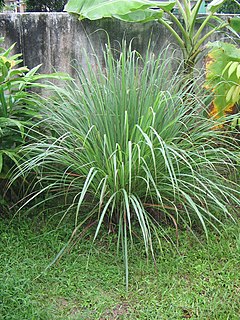
Cymbopogon, also known as lemongrass, barbed wire grass, silky heads, Cochin grass, Malabar grass, oily heads, citronella grass or fever grass, is a genus of Asian, African, Australian, and tropical island plants in the grass family. Some species are commonly cultivated as culinary and medicinal herbs because of their scent, resembling that of lemons . The name cymbopogon derives from the Greek words kymbe and pogon "which mean [that] in most species, the hairy spikelets project from boat-shaped spathes." Lemongrass and its oil are believed to possess therapeutic properties.
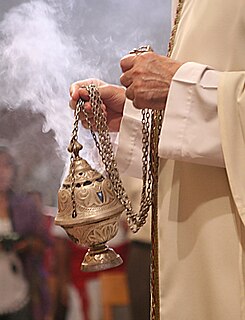
A censer, incense burner, perfume burner or pastille burner is a vessel made for burning incense or perfume in some solid form. They vary greatly in size, form, and material of construction, and have been in use since ancient times throughout the world. They may consist of simple earthenware bowls or fire pots to intricately carved silver or gold vessels, small table top objects a few centimetres tall to as many as several metres high. Many designs use openwork to allow a flow of air. In many cultures, burning incense has spiritual and religious connotations, and this influences the design and decoration of the censer.

Citronella oil is an essential oil obtained from the leaves and stems of different species of Cymbopogon (lemongrass). The oil is used extensively as a source of perfumery chemicals such as citronellal, citronellol, and geraniol. These chemicals find extensive use in soap, candles and incense, perfumery, cosmetic, and flavouring industries throughout the world. Citronella oil is also a plant-based insect repellent and has been registered for this use in the United States since 1948. The United States Environmental Protection Agency considers oil of citronella as a biopesticide with a non-toxic mode of action.

Citronellal or rhodinal (C10H18O) is a monoterpenoid aldehyde, the main component in the mixture of terpenoid chemical compounds that give citronella oil its distinctive lemon scent.
The holy anointing oil formed an integral part of the ordination of the priesthood and the High Priest as well as in the consecration of the articles of the Tabernacle and subsequent temples in Jerusalem. The primary purpose of anointing with the holy anointing oil was to sanctify, to set the anointed person or object apart as qodesh, or "holy".
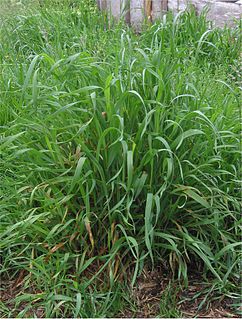
Elymus repens, commonly known as couch grass, is a very common perennial species of grass native to most of Europe, Asia, the Arctic biome, and northwest Africa. It has been brought into other mild northern climates for forage or erosion control, but is often considered a weed.

The Incense Trade Route was an ancient network of major land and sea trading routes linking the Mediterranean world with eastern and southern sources of incense, spices and other luxury goods, stretching from Mediterranean ports across the Levant and Egypt through Northeastern Africa and Arabia to India and beyond. These routes collectively served as channels for the trading of goods such as Arabian frankincense and myrrh; Indian spices, precious stones, pearls, ebony, silk and fine textiles; and from the Horn of Africa, rare woods, feathers, animal skins, Somali frankincense, gold, and slaves. The incense land trade from South Arabia to the Mediterranean flourished between roughly the 7th century BC and the 2nd century AD.

Cymbopogon ambiguus, or Australian lemon-scented grass, is a plant species in the family Poaceae. It has fragrant, bluish-green grey leaves and fluffy seed heads. It is self-fertile.

Cymbopogon flexuosus, also called Cochin grass, East-Indian lemon grass or Malabar grass, is a perennial grass native to India, Sri Lanka, Burma, and Thailand. It is placed in the genus Cymbopogon (lemongrasses).

Lagurus is a genus of Old World plants in the grass family, native to the Mediterranean Basin and nearby regions, from Azores and the Canary Islands to Crimea and Saudi Arabia. It is also naturalized in Australia, New Zealand, Ireland and Great Britain, and scattered locations in the Americas. The only known species is Lagurus ovatus, commonly called hare's-tail, hare's-tail grass or bunnytail. It is also grown as an ornamental plant for its attractive flower panicles.
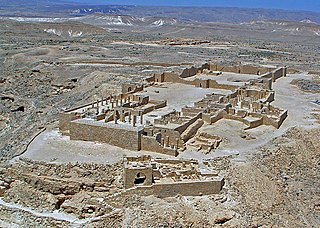
Incense Route – Desert Cities in the Negev is a World Heritage-designated area near the end of the Incense Route in the Negev, southern Israel, which connected Arabia to the Mediterranean in the Hellenistic-Roman period, proclaimed as being of outstanding universal value by UNESCO in 2005. The trade led to the development of ancient towns, forts and caravanserai en route, apart from agricultural development.

Cymbopogon citratus, commonly known as West Indian lemon grass or simply lemon grass, is a tropical plant native to Maritime Southeast Asia and introduced to many tropical regions.

Cymbopogon martinii is a species of grass in the genus Cymbopogon (lemongrasses) native to India and Indochina, but widely cultivated in many places for its aromatic oil. It is best known by the common name palmarosa as it smells sweet and rose-like. Other common names include Indian geranium, gingergrass, rosha, and rosha grass.

Cymbopogon schoenanthus, the camel grass, camel's hay, fever grass, geranium grass, or West Indian lemon grass, is a herbal plant of Southern Asia and Northern Africa, with fragrant foliage.
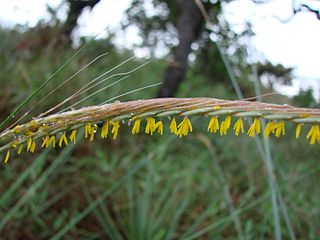
Trachypogon is a small genus of African and Latin American plants in the grass family. Crinkleawn grass is a common name for plants in this genus.
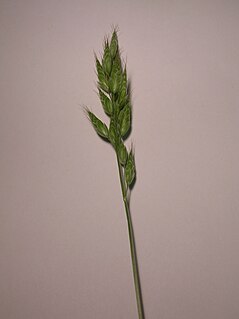
Bromus commutatus, the meadow brome, is an annual or biennial species of plant in the grass family Poaceae. In the United States it is known as hairy chess.
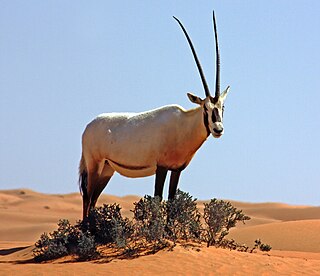
The wildlife of Qatar includes the peninsula's flora and fauna and their natural habitats. The country's terrestrial wildlife includes numerous small nocturnal mammals, a number of reptiles which mainly consist of lizard species, and arthropods. Aquatic animals primarily include fish, shrimp and pearl oysters. The desert and the shoreline form an important resting site for a number of migratory bird species during autumn and spring. Urban and agricultural developments have led to an increase in bird species.
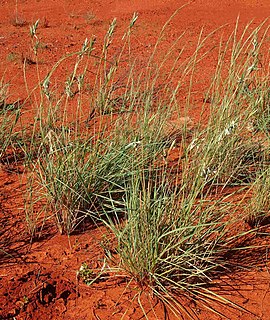
Cymbopogon bombycinus, or citronella grass is a perennial grass native to Australia.

Cymbopogon refractus, commonly known as barbed wire grass, is a perennial grass native to Australia.
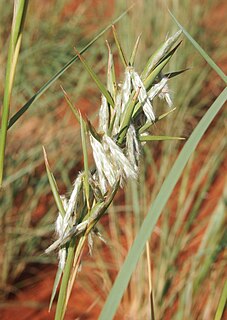
Cymbopogon obtectus is a species of perennial grass in the genus Cymbopogon. The grass is native to Australia and was described by Stanley Thatcher Blake in 1944. It is found in drier areas. The plant can be harvested in the wild to produce essential oil with medicinal properties. The plant is resilient to climate change, and has been used in re-vegetation projects.

















